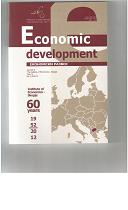European union labour market challenges and structural reforms after 2008 global financial crisis
European union labour market challenges and structural reforms after 2008 global financial crisis
Author(s): Aleksandra LozanoskaSubject(s): Economy
Published by: Економски институт - Скопје
Keywords: labor market; employment; unemployment; labour market policy,structural reforms.
Summary/Abstract: The paper addresses the challenges and structural reforms of the European Union labour market after 2008 global financial crisis. The challenges of the labour market derive from the decline of the number of employees and employment rates, as well as from the increase of the unemployment in EU-27 and its member states. The employment rate decreased from 65,9% (2008) to 64,2% (2010), while the unemployment rate increased significantly from 7,1% to 9,6% respectively. These changes made numerous challenges on the labour market which are related with the nonflexible wages in the EU, such as minimal wages, central determination of the wages, restrictive legal and institutional limits etc. The immobility of the workers among EU member states, as well as the decrease of the labour productivity, which is result of old and nonflexible industrial structure, are also a big challenges on the EU labour market. This implies needs for structural reforms on the EU labour market. They consist of few very important reforms such as: policies for activation and help during the unemployment, benefices for the unemployed persons, protection at work, trainings and lifelong learning, hiring tax incentives and child care facilities. The importance of the structural reforms is identified as essential, because only with efficient realization of these reforms the EU labor market will be shifted up, the employment will be maintained sustainable and the unemployment will decrease.
Journal: Економски Развој - Economic Development
- Issue Year: 14/2012
- Issue No: 2-3
- Page Range: 133-145
- Page Count: 13
- Language: English

